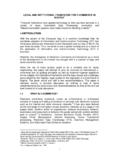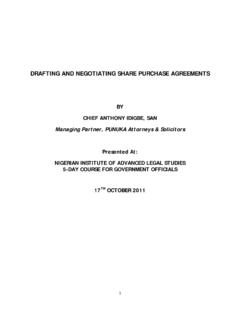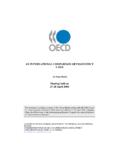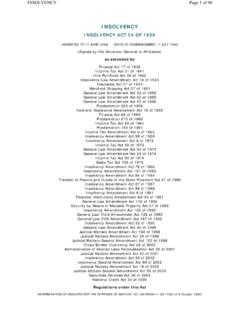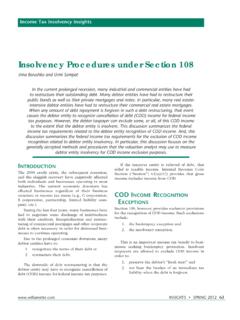Transcription of THE NIGERIAN INSOLVENCY LAW AND THE …
1 Page | 1 THE NIGERIAN INSOLVENCY LAW AND THE RIGHTS OF CREDITORS AND ACCOUNT HOLDERS OF INTERMEDIATED SECURITIES VIS- -VIS THE INSOLVENT INTERMEDIARY By Chief Anthony I. Idigbe SAN1 With the revolution caused by Information Technology, there has been a serious paradigm shift from traditional company & securities law to the law of securities accounts also known as intermediated ( indirectly held) securities law. This has in turn seriously impacted on the rights of trade and secured creditors to the company as well as those of investors who deal in the company s securities through intermediaries. New legal risks resulting from increased efficiency and speed in business transactions on an electronic and virtual platform need to be addressed by way of legislative reform or subsidiary legislative action when a basic existing framework pre-exists. In Nigeria, our basic framework is a now rather obsolete; the Companies and Allied Matters Act Cap.
2 C20 LFN 2004 (hereafter CAMA) only deals with issues arising from the direct holding system of company securities and fails in many respects to provide certainty in new areas of corporate, capital market and INSOLVENCY The development and growth of the banking and capital market sector in the NIGERIAN economy and the resulting need for a robust enforcement framework for secured credit through INSOLVENCY laws- has increased the urgency of the examination of the subject of the instant paper. The issues raised under this paper are as follows- what happens or what protection is afforded to investors when intermediaries such as custodian companies, stock broking firms, etc, become insolvent? How will the account of these investors who are holders of indirect and intangible rights in securities be treated? Shall there be special and separate treatment/priority given to those accounts or shall same be diluted into the intermediary s pool of intangible/tangible assets available to a gamut of institutional, non institutional and statutorily protected creditors in a set order of priority.
3 We will firstly in this paper give a general overview of INSOLVENCY in Nigeria, the treatment of diverse creditors and its effect on secured credit and capital market investments in Nigeria. We shall thereafter examine special national laws interfacing same with the loopholes existing in the general law and end with a comparative analysis with the international and cross-border approach of the (UNIDROIT) Draft Convention on Substantive Rules regarding Intermediated Securities. 1 Paper prepared jointly with Okorie Kalu Esq., Senior Associate PUNUKA Attorneys & Solicitors and delivered at SEC on UNIDROIT Workshop on Intermediated Securities held in Nigeria in May 2009 preparatory to adoption of draft Convention on Substantive Rules regarding Intermediated Securities. 2 The Investments & Securities Act 2007 has principally wrestled capital market matters from the Companies and Allied Matters Act.
4 Page | 2 PART I: SECURED CREDIT AND GENERAL INSOLVENCY FRAMEWORK What is INSOLVENCY ? How is the term understood in Nigeria? Section 650 of CAMA defines corporate INSOLVENCY as follows - "insolvent person" where used in this Decree means any person in Nigeria who, in respect of any judgment, decree or court order against him, is unable to satisfy execution or other process issued thereon in favour of a creditor, and the execution or other process remains unsatisfied for not less than six weeks; This definition requires the grant of a court order as a means to establish INSOLVENCY , but the truth is that corporate INSOLVENCY relates simply to the inability of a debtor company to meet up with its commercial commitments; that is to say, financial obligations arising from trade with third parties or secured lending. In financial accounting jargon on the other hand, balance sheet INSOLVENCY arises where the liabilities of the company exceeds the assets of the company3.
5 If follows that the definition of corporate INSOLVENCY in the Act is not only inadequate but inefficient Secured Credit on the other hand relate to lending and the process of enforcement of securities created as collateral to the loan transaction. To paraphrase the words of the UK Cork Committee, 1982 and other renowned experts in security rights such as Professor Sir Roy Goode, the importance of credit and more particularly secured credit- in modern day economies cannot be over-emphasized as it is almost impossible for a national economy to develop without an adequate secured credit law regime. It is the lifeblood of economy. Indeed, it is pertinent to point out in company law context that equity and debt capital provision by investors as well as supply of goods on credit are all premised on a credit transaction with the company with different maturity period and level of collateralization based on the assets of the company.
6 This in turn means rules of priority for the purpose of redistribution of these assets to various stakeholders when the company is insolvent are crucial. Thus, there is a very important connect between the law of Secured Credit and INSOLVENCY Law as typically the issue of enforcement of securities (whether in the form of transfer of rights in personal, real, tangible or intangible property) and the ranking of those securities arises only when the borrower is unable to meet with its commercial 3 From a practical point of view of INSOLVENCY practice, we venture to think that the process of mergers & acquisition under the ISA 2007 is a type of INSOLVENCY process which involves a voluntary dissolution of the existing company(s) and absorption of its liabilities- into a new entity without a voluntary formal process of winding-up (S122 (6) (d) ISA 2007).
7 The scheme is given sufficient publicity so that the interests of various creditors in a broad sense are protected. See also S34 of the Nigeria Deposit Insurance Corporation Act, 1990 (as amended) Page | 3 and contractual obligations. This means that the other side of the coin of the law of secured credit is the existence of an efficient and clear INSOLVENCY regime for the purpose of credit risk management through the enforcement of securities. Now, the NIGERIAN corporate INSOLVENCY framework (hereafter referred to as the general or normal/ordinary law) is captured by Part XIV, XV and XVI of CAMA on receivership, winding-up and arrangement & compromise respectively and envisages different levels of commercial difficulty, failure or INSOLVENCY of a going concern. In this context, dealings in securities are within the context of a Direct Holding or Certificated Securities System where an investor deals directly in the securities of the issuer company and is recognized either as a member or a secured creditor of the debtor company in the relevant registers (Ss.)
8 151, 152) of the company with the attendant rights attached to his class of securities. For instance, aside from the subscribers to the memorandum of a company, S79(2) CAMA defines a member of a company as one who agrees in writing to become a member of a company, and whose name is entered in its register of members , whilst S151(2) on transfer of shares states that it shall not be lawful for the company to register a transfer of shares in the company unless a proper instrument of transfer has been delivered to the company , again S151(3) provides that once the instrument of transfer is executed between the parties .. the transferor shall be deemed to remain a holder of the share until the name of the transferee is entered in the register of members in respect of the share (see also Ss 91 and 152(2)). The same idea goes for debenture holder under S169.
9 Now then, under the normal law, the administration and management of the undertaking may be subjected either to a temporary takeover of control, a joint management by the secured creditor for the purpose of liquidation of the secured obligation of the company, or a restructuring of the undertaking and the rights of (classes of ) members, debenture holders and creditors: these best case scenarios of business recovery of the vulnerable undertaking are the ones contemplated by Part XIV and XVI with the appointment of a receiver/manager and the concept of arrangement/compromises with (classes of) members and or secured creditors. To a relatively large extent, these scenarios entail the collaboration of the insolvent company with several other stakeholders such as institutional creditors or regulators, secured creditors, trade creditors and employees and a balancing act as per these several interests.
10 The normal law also envisages instances where those stakeholders would compulsorily or voluntarily put the insolvent company to death and has established priority rules (see Ss. 484, 494 and 495 primarily but also see Ss. 393(1), 402 to 404,413,414 and 448) to guide redistribution of the proceeds realized from the assets of the failed company. By virtue of these provisions, preference is given to secured creditors holding either a legal mortgage or debenture on company s specific assets, followed by the costs, expenses and remuneration of the liquidators arising from INSOLVENCY administration (receivership/winding-up/liquidation), followed by state revenue (tax and other fiscal Page | 4 deductions and dues, labour debts which rank equally). Trade creditors and holders of floating debentures are at the bottom of the pyramid, followed by contributories.
